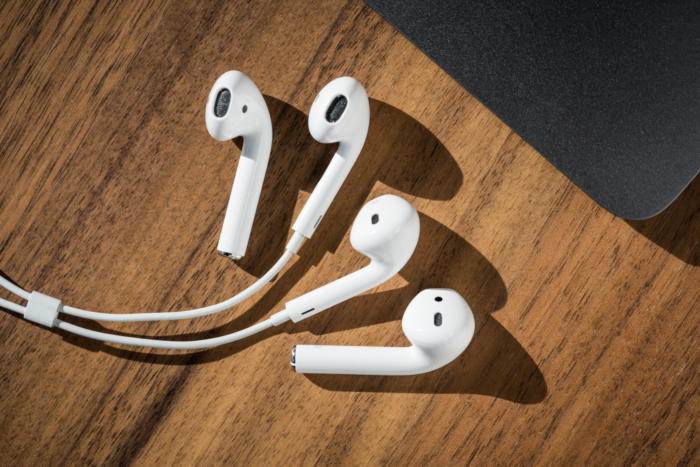When Apple pulled the headphone jack off the iPhone 7, it also unveiled a new set of wireless earbuds called AirPods, that it claimed were so great that users wouldn’t mind the missing headphone jack. Then the AirPods didn’t come out for nearly three months after the iPhone, but now that they’re here, they’ve solved every problem an iPhone 7-using music lover could have, right?
Oh, heavens no. Like so many Apple products before them, the AirPods bring with them as big of a problem as they’re solving. With no onboard buttons, the AirPods require users to ask Siri to do everything from changing a track to adjusting the volume, and Siri just doesn’t have the same abilities in all music apps—an arbitrary restriction set by Apple to steer you toward Apple Music.
The fit
But let’s start with the first question everyone has about the AirPods. Aren’t you worried they will fall out of your ears? As soon as they were announced, even Conan O’Brien had to make fun, producing a parody of the old iPod commercials, only with AirPods flying off in all direction with the slightest move of the dancers’ heads.
 Adam Patrick Murray
Adam Patrick MurrayThe wireless AirPods resemble the EarPods, but the AirPods have a heftier, more substantial feel that stays put in my ears.
That’s funny, but it’s bull. The AirPods stay put when I’m dacing, headbanging, jogging, hanging upside down, riding my stationary bike, sprinting to catch the bus, and shaking my head around smacking my temple like I’m trying to dislodge water stuck in my ear. Really, they aren’t going to fall out. Check the video above for proof.
My skin is on the oily side, and sometimes in-ear ’buds with silicone tips get a little oily, and I have to wipe them off or keep shoving them further into my ears for a good seal. The wired Apple EarPods (you know, the cheap pair that comes with your iPhone) fit me OK—I’ve been wearing them since the iPhone 7 launch, to eventually compare with these. But the wire does trip me up from time to time, getting snagged on the armrests when I walk up the bus aisle, or requiring adjustment when I’m wearing a scarf. I wanted to go wireless, but the AirPods had to be comfortable enough to wear all day, and not fall out. They’re very comfortable, virtually the same shape as the EarPods but with more heft. They perch right in my ear openings and stay put, better than EarPods or silicone-tipped earbuds.
The sound
I put comfort before sound because I’m not an audiophile. I listen to tons of music and I can tell good earphones from terrible ones, but the included EarPods suit me just fine for streaming music and podcasts. I used to rock a $130 pair of Bose MIE2i in-ear ’phones (since discontinued) when my iPhones had jacks for them, and I expected the AirPods to fall somewhere in between. They sound great, just as good as the Bose set—the sound is full and detailed, and they get plenty loud.
 Adam Patrick Murray
Adam Patrick MurrayThe AirPods sound better than the EarPods, but they have that same kind of fit, where the bud itself just rests in your ear opening, instead of going way down into your ear canal. And since they don’t have a silicone or foam tip like the ’buds that get shoved more deeply into your ear, they don’t seal off outside noise as fully. But their impressive volume quickly drowns out your surroundings. Once my iPhone is at about 60 volume, I can no longer hear myself speak at a normal volume, while I’m wearing the AirPods.
The white stems that hang down from the AirPods hold the microphone, which you’ll need for voice calls, and speaking with Siri. I used Siri to make a voice call both indoors and outdoors, and the people I chatted with reported a slight echoy sound common to Bluetooth phone calls, but only when I really pressed them to evaluate my sound. All in all the sound was good enough for calls.
The controls
Speaking to Siri, though, mars the AirPods experience somewhat. To turn up the volume with the EarPods, you click a button on the inline remote. With the AirPods, first you check to see if your iPhone is in arm’s reach, and if it is, use the volume buttons on that. Because otherwise you have to double-tap one AirPod, wait for your music to pause and the Siri chime to sound, say “Turn it up,” or even better “turn up the volume” just to make sure Siri will understand, and then wait another couple of beats for your music to resume, now two notches louder. If you say “Turn it up to 50%,” the volume still gets turned up two notches louder.
 IDG
IDGIn this case, “Go back a track” would start the current song over, but who wants to engage in trial-and-error with laggy Siri when you used to have a button for this?
Siri can also control Apple Music and your own music collection stored in Apple’s own Music app. But Apple chose not to give full Siri control to third-party music apps, and that’s a huge bummer when you try to use earbuds that require the use of Siri. In Spotify, I could turn the volume up and down, and skip to the next track. But to start a song over (three clicks on the EarPods remote, thank you very much), I couldn’t say “start this song over,” although “go back one track” was more responsive. And obviously I couldn’t call up specific artists, albums, playlists, and songs. The AirPods are at their best when you are all-in with Apple devices and services. If you’re a die-hard user of Spotify or Pandora, these might not be the headphones for you.
But either way, Siri is just too slow and buggy to be a rock-solid control set. I quickly found myself wanting to just use the controls on the iPhone itself. As a side note, I’ve never appreciated iOS 10’s Raise to Wake feature as after I got my AirPods, since I can bring up the lock screen play/pause, forward, and rewind buttons so easily, and leave Siri out of it.
 Adam Patrick Murray
Adam Patrick MurrayThe EarPods are easier to control. But the AirPods never tangle, so…
The auto-pause feature does work well, and mostly seamlessly across apps. When you are listening to the AirPods, and you take one out of your ear, the sound pauses. When you put it back in your ear, it’ll start playing again. While the feature is mostly solid, it isn’t a sure thing. A few times the music would start playing again after I’d stuck one AirPod in my jacket pocket while talking to a cashier. Other times, taking an AirPod out would pause a podcast in Pocket Casts, but putting it back in wouldn’t start it playing again; I had to hit Play on the iPhone itself. If you do want to play music on only one AirPod for some reason, you can just press Play on the iPhone after taking one out.
Even with a little finicky behavior, I love this feature. I’m also testing a pair of Libratone wireless headphones right now, and they have a feature where you can mute the sound by cupping your hand over one ear. I’m glad companies are thinking about easy ways to silence the sound so you can say hi to neighbors or conduct a transaction politely. But pausing is better than muting, especially for podcast fans, so AirPods have the edge there.
The little things
Because Apple makes these, the AirPods are locked in to iOS 10 like no other headphones will ever be. You can check the battery life in the Battery widget in Notification Center. Even just opening the charging case with the AirPods inside will pop up a notification on your phone showing the charge level of your AirPods (left and right—strangely, they don’t wear down at exactly the same level).
 Adam Patrick Murray
Adam Patrick MurrayA little LED inside the case glows green when the AirPods are mostly charged, orange when they need charge. A more accurate meter is on the iPhone.
The charging case is brilliant. It’s small and white and easy to stash in a pocket or bag. It kind of looks like a fancy package of dental floss, with a top that flips open and shut with a tight magnetic click. The AirPods charge inside this case, so if you keep them there when they’re not in your ears, and then remember to charge the case now and then, keeping the AirPods charged isn’t too much of a burden. The case itself charges via a Lightning port, so I just try to remember to top it off while I’m using the AirPods at my desk.
In my tests, the AirPods easily get Apple’s stated 5 hours of music time per charge. I’m at 5 hours on my stopwatch right now, in fact, and the AirPods have 12 percent charge left according to the Battery widget in iOS 10. Apple says the case should have about 24 hours of battery life in it, and just 15 minutes in the case can power your AirPods for three more hours (it got me from 4 percent to 79). The AirPods make a sad little sound when they reach 10 percent so you’ll know they’re almost out of juice.
Connecting the AirPods to an iPhone for the first time is as easy as opening the case. A message pops up on the iPhone offering to connect, and when you do, the AirPods also appear in the Bluetooth menu of any Macs (running macOS Sierra) you use with the same iCloud account. Switching to an iPad and Apple Watch with the same iCloud account is similarly easy, and you don’t have to trick your iPhone into unpairing with the AirPods to listen to them on a different device. They’re always paired to everything, and you can just select AirPods on that thing and press play.
 Adam Patrick Murray
Adam Patrick MurrayThis button lets you pair to a non-Apple device, if you must.
The back of the charging case has a round white button that’s barely visible. With the AirPods in the open case, you can press and hold that button to turn a tiny LED in the case white. That means they’re in pairing mode, and you can pair them to an Android phone or another Bluetooth device, although without Siri or the extra features. I haven’t experimented with that for this review, but we’ll do a followup soon.
Bottom line
The three-button remote on wired earbuds is a much faster, easier way to control your music than…






